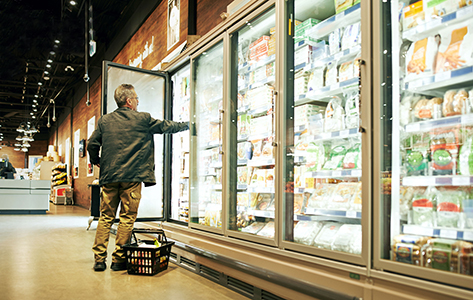Using Internet of Things (IoT)-based systems to automate temperature monitoring in refrigerators and freezers offers several benefits to restaurants. Following we look at how automated temperature monitoring works and how to get started with IoT.
How it Works: Automated Temperature Monitoring in Action
IoT-based systems use sensors to continuously monitor temperatures in refrigerators and freezers. These sensors are mounted inside the cold storage units in the warmest part of the unit, typically near the door or opening. The sensors collect temperature readings periodically and transmit the data to the cloud. As the data is recorded, the system can detect and report any anomalies.
If the conditions inside a refrigerator or freezer fall outside of predetermined thresholds, managers and staff can be notified (via text, email, or in-store apps) so they can take quick corrective actions outlined in their risk mitigation plans. In addition, the data that is recorded and stored can be analyzed to help identify trends that can be used to inform maintenance schedules and make operations more efficient. For example, the data may show how many years (on average) a refrigerator will last before it fails, so an organization can plan to buy replacement units before a failure occurs.
Benefits of Automated Temperature Monitoring
The positive impacts of automated temperature monitoring, enabled by IoT, are often realized in four key areas:
Food Safety. Maintaining a controlled environment in refrigerators, freezers, and other food storage areas reduces the risk of spoilage. By automating the monitoring process, organizations can keep a continuous watch on cold storage units and alert staff if temperatures rise above predetermined thresholds, allowing them to take immediate corrective action based on their risk mitigation processes. This is particularly beneficial in situations where a refrigerator door might be kept open too long, a freezer door is not entirely shut, or during a power outage.
Regulatory compliance. Regulatory agencies require reporting of food safety compliance. Typically, this is a human-driven process, with manual checks of thermometers and handwritten logs. IoT technologies that automatically monitor and record temperatures provide easy reporting of temperature levels over time. This streamlined process makes it much faster—and easier—to demonstrate compliance.
Efficiency. Automated temperature monitoring can make back-of-house restaurant processes more efficient by eliminating the manual “check and record” processes mentioned above. This frees up staff time to focus on other important tasks, such as serving customers.
Sustainability. By reducing food waste due to spoilage, automated temperature monitoring supports sustainability goals.
How to Get Started
With a wide range of IoT devices and systems available, selecting the right one can be overwhelming. How can you get started? First, identify your organization’s overall goals in incorporating the new technologies, and then review those high-level goals as you investigate options. Here are some criteria to consider:
Device selection: When selecting IoT devices, one size does not fit all. Different devices deliver varying degrees of functionality. Some devices support a single use case, while others have multiple sensors to enable diverse use cases for scalability. Another consideration is battery life. Seek devices that offer extended battery life by leveraging user-replaceable batteries designed for low temperature environments. Other features to look for include use of food-grade plastics and support for firmware updates over the air (FUOTA).
Wireless technology: To effectively penetrate dense refrigerator materials (typically metal), most food service operators are using the open standard, LoRaWAN due to its ability to penetrate walls and maximize battery life.
Data caching: In the event of an interruption in connectivity, you must know what the refrigerator or freezer temperatures were during the outage. Some devices and gateways can cache data and resend as soon as they reconnect, while others cannot. Temperature data caching is critical for applications related to food safety, so be sure to ask for this during the research and evaluation process.
Deployment capabilities: Deployments are complex, and a provider that can navigate deployments at scale is vital. It is important to look at each provider’s technology offerings, installation, and deployment capabilities.
There are many benefits to using IoT to deliver automated temperature monitoring, and these benefits extend beyond food safety to sustainability and improved efficiency. They key is to identify the right devices for your organization’s specific needs.



















